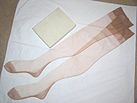Boothose

Boothose (boot-hose, boot hose) are over-stockings or boot liners worn in the sixteenth and seventeenth centuries to protect fine knitted stockings from wear. They first appear around 1450.[1]
Originally a practical item, they were later made of fine linen and sported elaborate lace and embroidered boothose tops.[1][2] By 1583 Philip Stubbs in his Anatomie of Abuses could decry "The vain excesse of botehosen"
...they must be wrought [embroidered] all ouer, from the gartering place vpward, with nedle worke, clogged with silk of all colors, with birds, foules, beasts, and antiques purtrayed all ouer in comlie sorte. So that I haue knowen the very nedle work of some one payre of these bootehose to stand, some in .iiij. pound, vi. pound, and some in x. pound a péece.[3]
In the 17th century, linen boothose could be trimmed with lavish lace tops turned down over cuffed bucket-topped boots.[4] In mid-century, it was briefly stylish to wear boothose with low-cut shoes, before boothose fell completely out of fashion. They lingered, once again a practical object, under the name boot stockings into the 18th century.[1]
Text is available under the CC BY-SA 4.0 license; additional terms may apply.
Images, videos and audio are available under their respective licenses.

